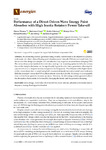Performance of a Direct-Driven Wave Energy Point Absorber with High Inertia Rotatory Power Take-off
| dc.contributor.author | Thomas, S | |
| dc.contributor.author | Giassi, M | |
| dc.contributor.author | Göteman, M | |
| dc.contributor.author | Hann, Martyn | |
| dc.contributor.author | Ransley, E | |
| dc.contributor.author | Isberg, J | |
| dc.contributor.author | Engström, J | |
| dc.date.accessioned | 2018-09-04T17:48:49Z | |
| dc.date.issued | 2018-09-04 | |
| dc.identifier.issn | 1996-1073 | |
| dc.identifier.issn | 1996-1073 | |
| dc.identifier.other | 9 | |
| dc.identifier.uri | http://hdl.handle.net/10026.1/12227 | |
| dc.description.abstract |
<jats:p>An alternating rotatory generator using an eddy current break is developed as a physical scale model of a direct-driven floating point absorber power take-off (PTO) for wave tank tests. It is shown that this design is a simple and cost-effective way to get an accurate linear damping PTO. The device shows some beneficial characteristics, making it an interesting option for full scale devices: For similar weights the inertia can be significantly higher than for linear generators, allowing it to operate with natural frequencies close to typical wave frequencies. The influence of the higher inertia on the power absorption is tested using both a numerical simulation and physical wave tank tests. With the increased inertia the PTO is able to absorb more than double the energy of a comparable direct-driven linear generator in some sea states. Moreover, the alternating rotatory generator allows the absorption characteristic to be tuned by changing the inertia and the generator damping.</jats:p> | |
| dc.format.extent | 2332-2332 | |
| dc.language | en | |
| dc.language.iso | en | |
| dc.publisher | MDPI | |
| dc.subject | wave energy | |
| dc.subject | power take-off | |
| dc.subject | direct-driven | |
| dc.subject | wave tank test | |
| dc.subject | physical scale model | |
| dc.subject | natural frequency tuning | |
| dc.subject | floating point absorber | |
| dc.title | Performance of a Direct-Driven Wave Energy Point Absorber with High Inertia Rotatory Power Take-off | |
| dc.type | journal-article | |
| dc.type | Journal Article | |
| plymouth.author-url | https://www.webofscience.com/api/gateway?GWVersion=2&SrcApp=PARTNER_APP&SrcAuth=LinksAMR&KeyUT=WOS:000446604500153&DestLinkType=FullRecord&DestApp=ALL_WOS&UsrCustomerID=11bb513d99f797142bcfeffcc58ea008 | |
| plymouth.issue | 11 | |
| plymouth.volume | 11 | |
| plymouth.publication-status | Published online | |
| plymouth.journal | Energies | |
| dc.identifier.doi | 10.3390/en11092332 | |
| plymouth.organisational-group | /Plymouth | |
| plymouth.organisational-group | /Plymouth/Faculty of Science and Engineering | |
| plymouth.organisational-group | /Plymouth/Faculty of Science and Engineering/School of Engineering, Computing and Mathematics | |
| plymouth.organisational-group | /Plymouth/REF 2021 Researchers by UoA | |
| plymouth.organisational-group | /Plymouth/REF 2021 Researchers by UoA/UoA12 Engineering | |
| plymouth.organisational-group | /Plymouth/Users by role | |
| plymouth.organisational-group | /Plymouth/Users by role/Academics | |
| plymouth.organisational-group | /Plymouth/Users by role/Researchers in ResearchFish submission | |
| dcterms.dateAccepted | 2018-08-30 | |
| dc.rights.embargodate | 2018-9-8 | |
| dc.identifier.eissn | 1996-1073 | |
| dc.rights.embargoperiod | Not known | |
| rioxxterms.versionofrecord | 10.3390/en11092332 | |
| rioxxterms.licenseref.uri | http://www.rioxx.net/licenses/all-rights-reserved | |
| rioxxterms.licenseref.startdate | 2018-09-04 | |
| rioxxterms.type | Journal Article/Review |


